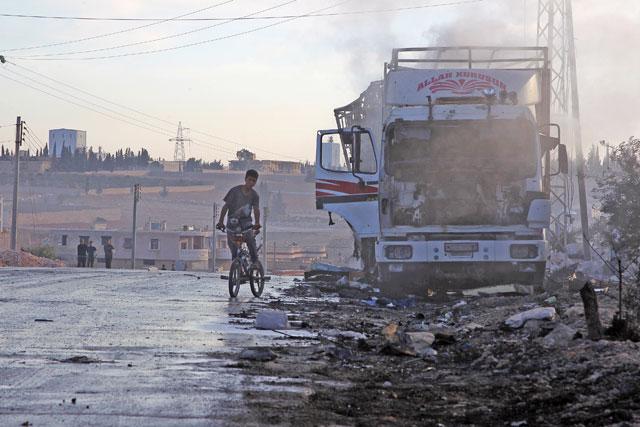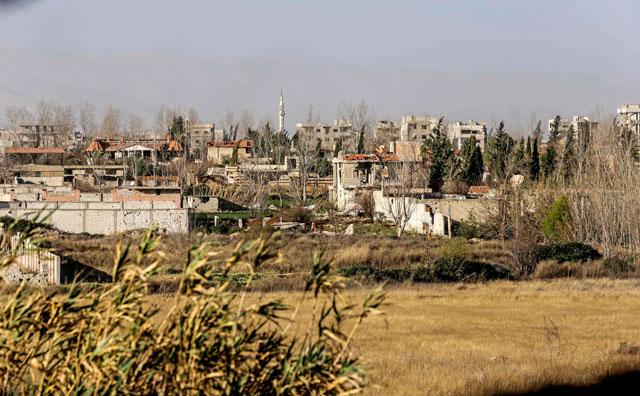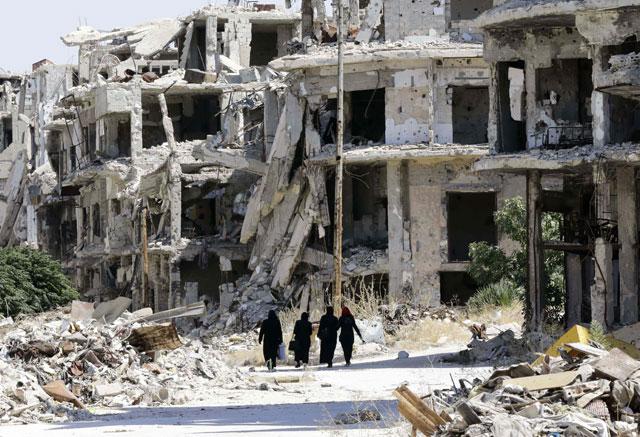You are here
UN rows back from describing Syria convoy attack as ‘air strikes’
By Reuters - Sep 21,2016 - Last updated at Sep 21,2016

A boy rides a bicycle near a damaged aid truck after an air strike on the rebel held Urm Al Kubra town, western Aleppo city, Syria, on Tuesday (Reuters photo)
GENEVA/BEIRUT — The United Nations rowed back on Tuesday from describing an attack on an aid convoy in Syria as air strikes, saying it did not have conclusive evidence about what had happened.
The incident, in which 18 trucks from a 31-vehicle convoy were destroyed on Monday evening, had looked likely to deal a death blow to a week-old ceasefire. It drew vigorous denunciations from around the world.
The UN, Red Cross and United States had all described it as an air strike, implicitly pinning the blame on Russian or Syrian aircraft that fly in the area for breaking the ceasefire with a strike on a humanitarian target.
But Russia, which denied its aircraft or those of its Syrian government allies were involved, said on Tuesday it believed the convoy was not struck from the air at all but had caught fire because of some incident on the ground.
The Syrian Red Crescent said the head of one of its local offices and "around 20 civilians" had been killed, although other death tolls differed.
After the Russian explanation, the UN put out a revised version of an earlier statement, removing wording on “air strikes” and replacing it with references to unspecified “attacks”.
UN humanitarian spokesman Jens Laerke said the references to air strikes in the original statement, attributed to the top UN humanitarian officials in the region and in Syria, were probably the result of a drafting error.
“We are not in a position to determine whether these were in fact air strikes. We are in a position to say that the convoy was attacked,” he said.
Washington said it still believed the attacks were the result of an air strike, which could only have been carried out by Russia or the Syrian military.
“For a convoy to be targeted in an air strike is truly outrageous. Again we don’t know exactly what happened, we’re working through it, but we think it was an air strike,” said Brett McGurk, the US presidential envoy to the coalition fighting against Daesh in Syria and Iraq.
The attack on Monday evening prompted the UN to suspend all aid shipments into Syria and brought the latest peace efforts to the brink of collapse.
Secretary of State John Kerry, who personally negotiated the ceasefire during months of diplomacy in the face of scepticism from other senior US officials, met 20 other foreign ministers including Russia’s Sergei Lavrov.
“The ceasefire is not dead,” Kerry said.
‘War crime if deliberate’
The ceasefire was meant to halt all fighting and allow aid to reach besieged areas, at a time when pro-government forces, with Russian and Iranian military support, are in their strongest positions for years and civilians in many rebel-held areas are cut off from food and medical supplies.
“If this callous attack is found to be a deliberate targetting of humanitarians, it would amount to a war crime,” UN aid chief Stephen O’Brien said in a statement. Peter Maurer, president of the International Committee of the Red Cross (ICRC) called it a “flagrant violation of international humanitarian law”.
At a briefing on Tuesday morning, Benoit Carpentier, a spokesman for the International Federation of Red Cross and Red Crescent Societies, described the incident as “air strikes”. He was not immediately available to respond to questions about whether the Red Cross stood by that characterisation after Russia gave its explanation.
Igor Konashenkov, a spokesman for Russia’s defence ministry, said in a statement: “We have studied video footage from the scene from so-called ‘activists’ in detail and did not find any evidence that the convoy had been struck by ordnance.”
“There are no craters and the exterior of the vehicles do not have the kind of damage consistent with blasts caused by bombs dropped from the air.”
He said the damage to the convoy visible in footage was caused by its cargo catching fire. It had occurred at the same time as militants from the group formerly called Al Nusra Front had started a big offensive in nearby Aleppo, he said, appearing to point the finger at rescue workers from a group called the “White Helmets” who filmed the aftermath.
“Only representatives of the ‘White Helmets’ organisation close to Al Nusra Front who, as always, found themselves at the right time in the right place by chance with their video cameras can answer who did this and why.”
Hussein Badawi, head of the White Helmets in the town, said he was 100 metres from the aid depot when the air strikes took place and was injured by shrapnel in the hand.
“There were fires, martyrs, wounded people. We were able to pull out four survivors and five dead bodies at first,” Badawi said. “The bombardment was continuous, continuous. The rescue teams weren’t even able to work. Those who arrived in ambulances couldn’t come in.”
Diplomatic gamble
The ceasefire deal was a gamble on unprecedented cooperation between the United States and Russia, despite trust between the two Cold War-era foes being at its lowest point for decades.
They support opposite sides in the war between Assad’s government and insurgents but are both fighting against Daesh militants. The deal calls for Washington and Moscow to share targetting information eventually, the first time they would have fought openly together since World War II.
Following the attack, a senior Obama administration official said of the ceasefire: “We don’t know if it can be salvaged.”
“At this point the Russians have to demonstrate very quickly their seriousness of purpose because otherwise there will be nothing to extend and nothing to salvage,” the official, who spoke to reporters on condition of anonymity, added.
Following Monday’s attack, there were reports of intensified clashes across Syria.
The Syrian Observatory for Human Rights, a Britain-based monitor of the war, said clashes took place between the army and rebels in the Jobar district of Damascus and areas northeast of the capital, after the army tried to advance.
Near the central city of Homs, the army shelled one village, while helicopters and warplanes bombed several other places, including the rebel-held town of Rastan, it said.
Related Articles
HAMMOURIYA, Syria — Syrian forces pursued a relentless air and ground offensive against Eastern Ghouta on Thursday, moving closer to retakin
ALEPPO, Syria — The UN suspended all humanitarian convoys in Syria on Tuesday following a deadly air strike on aid trucks, as fighting inten
BEIRUT — Syria's military declared a week-long ceasefire over on Monday and vowed to continue fighting, even as officials from the United St

















